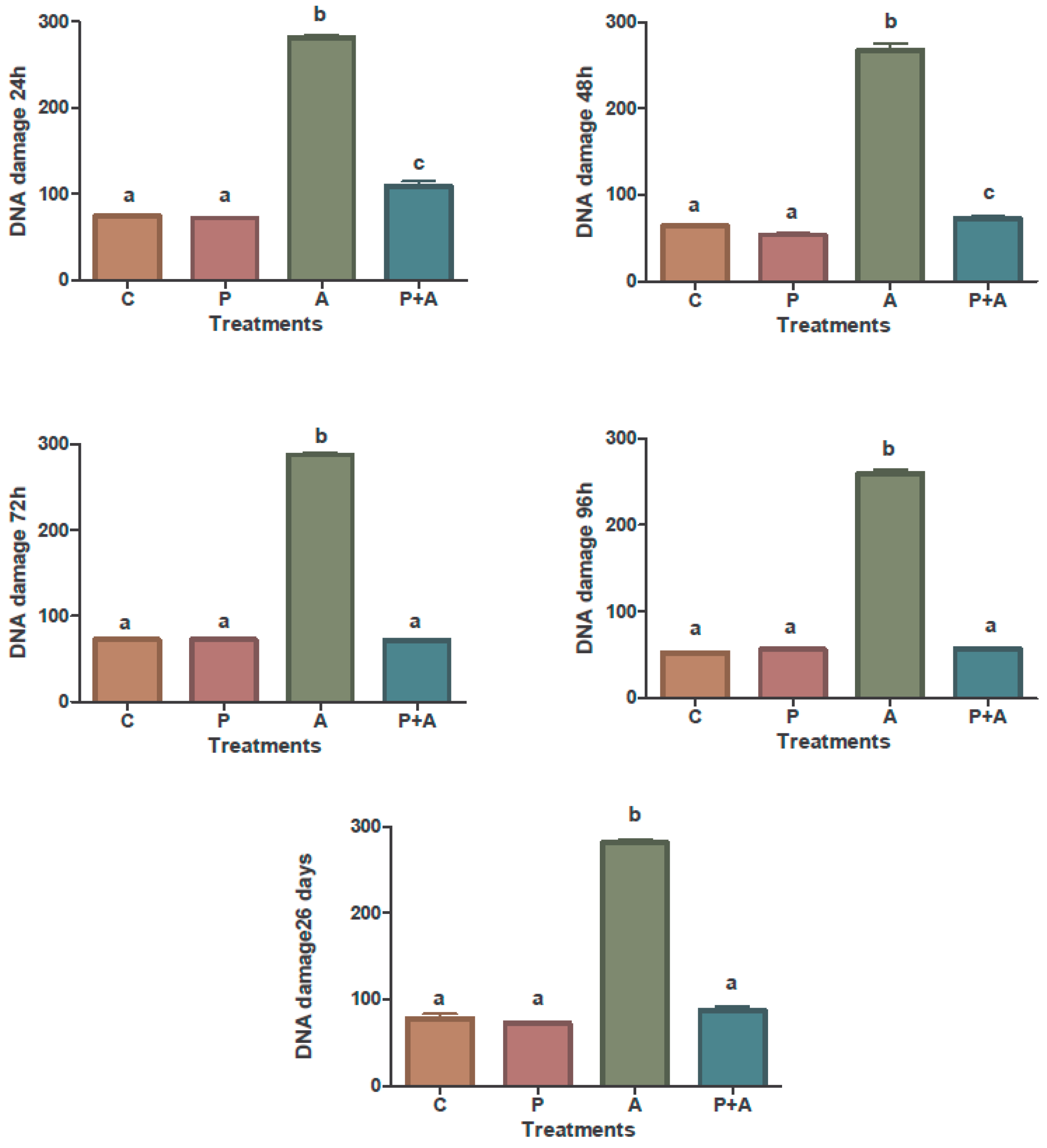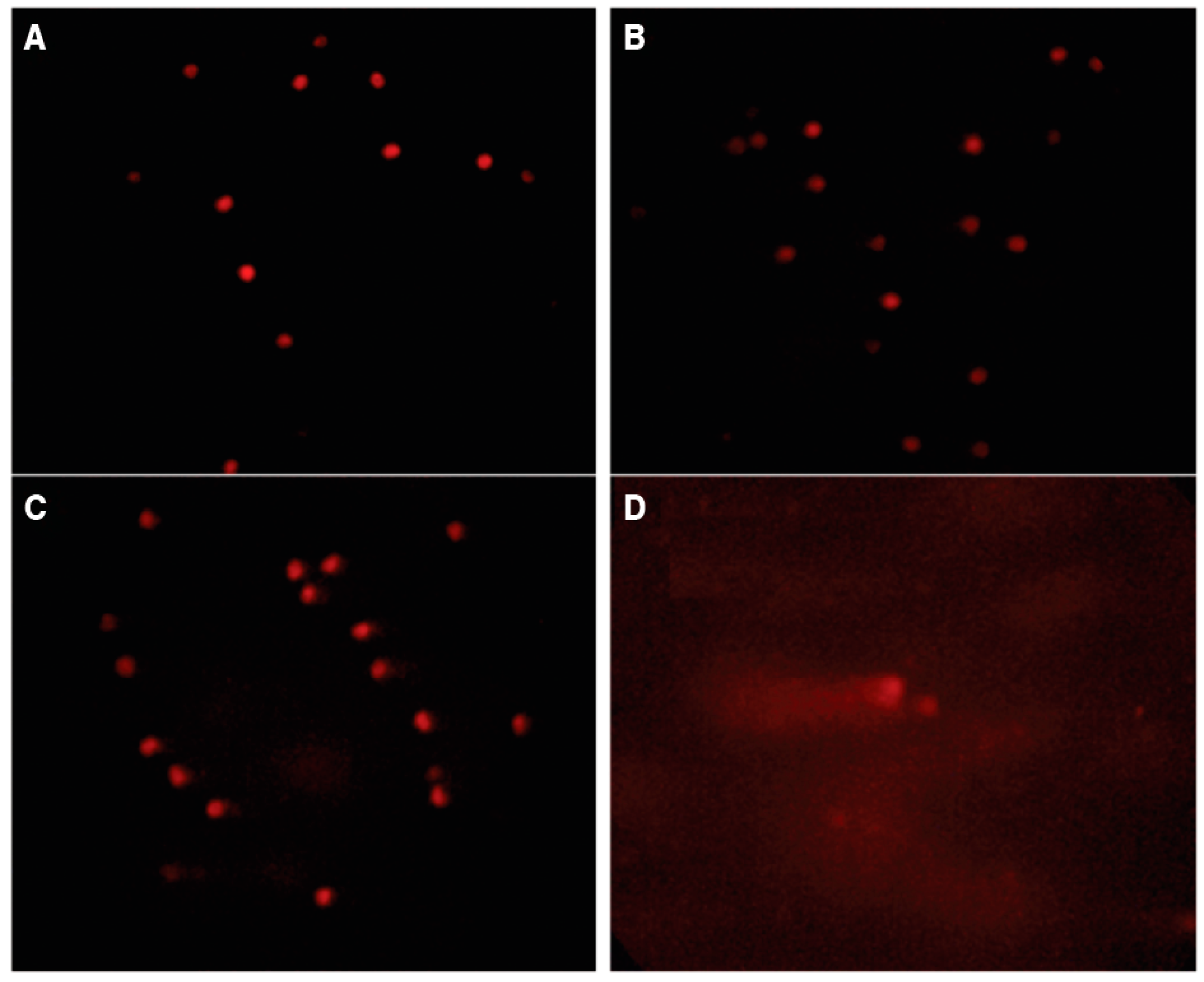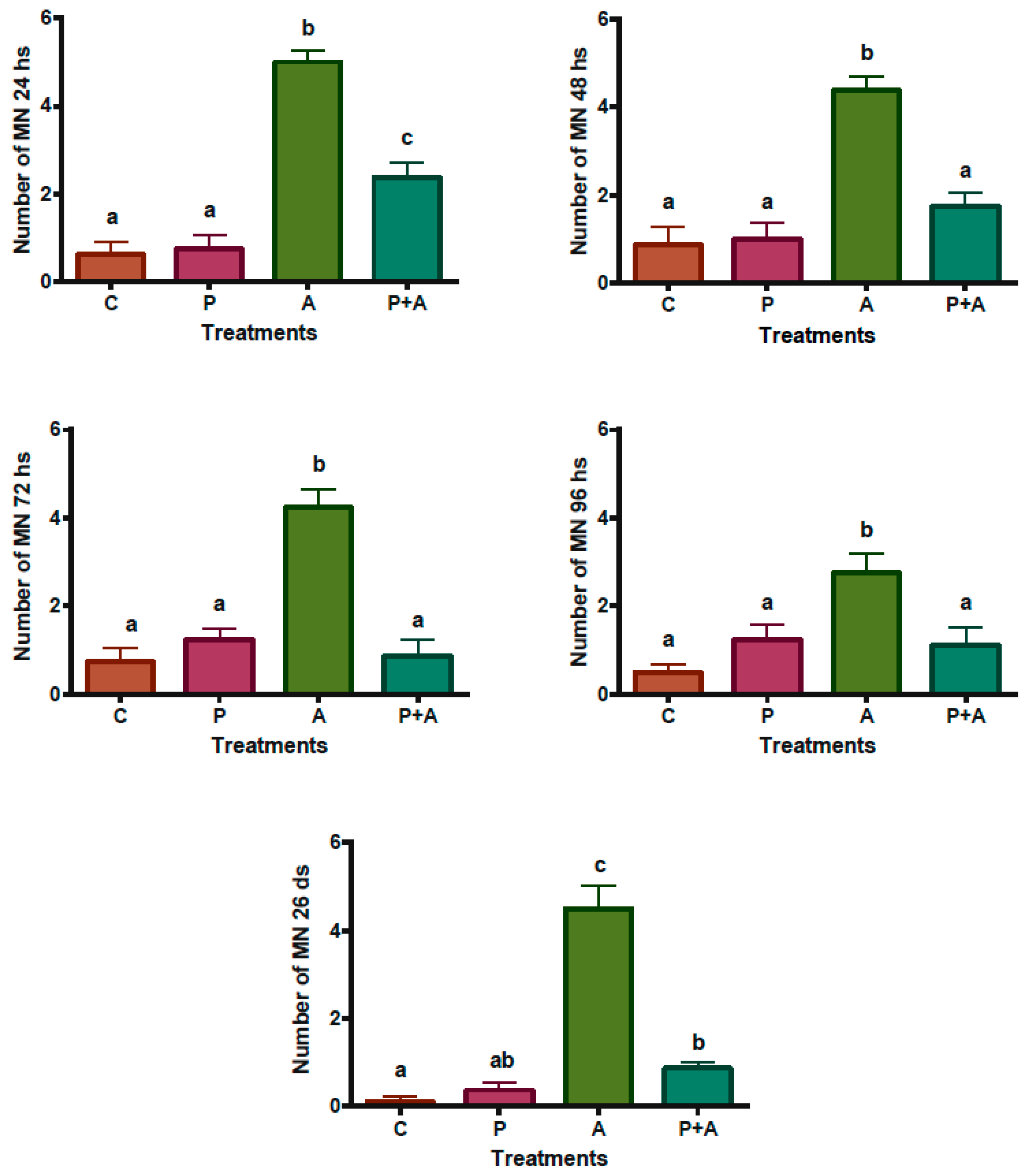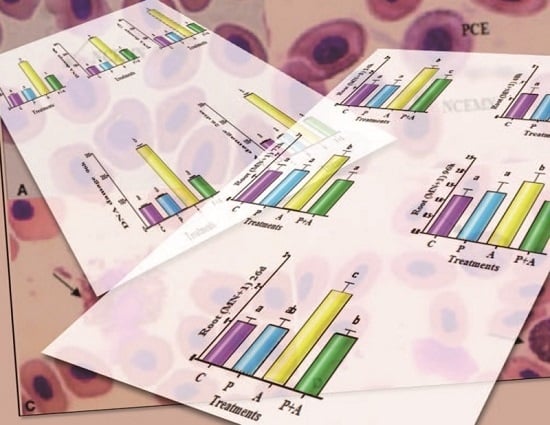Antigenotoxic Effect of Piperine in Broiler Chickens Intoxicated with Aflatoxin B1
Abstract
:1. Introduction
2. Results and Discussion
3. Conclusions
4. Experimental Section
4.1. Materials
4.1.1. Broiler Feed
4.1.2. Preparation of Piperine
4.1.3. Addition of Piperine to Broiler Feed
4.1.4. Aflatoxin B1
4.1.5. Chick Treatments
4.1.6. Broiler Performance
4.1.7. Genotoxicity Assay
4.1.8. Statistical Analysis
4.2. Ethical Statement
Acknowledgments
Author Contributions
Conflicts of Interest
References
- Council of Agricultural Science and Technology (CAST). Mycotoxins: Risks in Plant, Animal and Humans; Richard, J.L., Payne, G.A., Eds.; Task Force Report No. 139; Council of Agricultural Science and Technology (CAST): Ames, IA, USA, 2003; p. 199. [Google Scholar]
- Oswald, I.P.; Marin, D.E.; Bouhet, S.; Pinton, P.; Taranu, I.; Acccensi, F. Immunotoxicological risk of mycotoxins for domestic animals. Food Addit. Contam. 2005, 22, 354–360. [Google Scholar] [CrossRef] [PubMed]
- Tessari, E.N.C.; Cardoso, A.L.S.P. A Aflatoxina em frangos de corte. Available online: http://www.biologico.sp.gov.br/artigos_ok.php?id_artigo=78 (accessed on 29 October 2016). (In Portuguese)
- Bailey, G.S.; Williams, D.E.; Wilcox, J.S.; Loveland, P.M.; Coulombe, R.A.; Hendricks, J.D. Aflatoxin B1 carcinogenesis and its relation to DNA adduct formation and adduct persistence in sensitive and resistant salmonid fish. Carcinogenesis 1988, 9, 1919–1926. [Google Scholar] [CrossRef] [PubMed]
- Kubena, L.F.; Harvey, R.B.; Bailey, R.H.; Buckley, A.S.; Rottinghaus, G.E. Effects of hydrated sodium calcium aluminosilicate (T-BindTM) on mycotoxicosis in young broiler chickens. Poult. Sci. 1998, 77, 1502–1509. [Google Scholar] [CrossRef] [PubMed]
- Parlat, S.S.; Yildiz, A.O.; Oguz, H. Effects of clinoptilolite on fattening performance of Japanese quail (Coturinix coturnix japonica) during experimental aflatoxicosis. Br. Poult. Sci. 1999, 40, 495–500. [Google Scholar] [CrossRef] [PubMed]
- Babu, D.; Muriana, P.M. Sensitive quantification of aflatoxin B1 in animal feeds, corn feed grain, and yellow corn meal using immunomagnetic bead-based recovery and real-time immunoquantitative-PCR. Toxins 2014, 12, 3223–3237. [Google Scholar] [CrossRef] [PubMed]
- Coulombe, R.A. Aflatoxins. In Mycotoxins and Phytoallexins; Sharma, R.P., Salunkhe, D.K., Eds.; CRC Press: BocaRaton, FL, USA, 1991; pp. 103–143. [Google Scholar]
- Ziringue-Junior, H.J.; Bhatnagar, D.; Cleveland, T.E. C15H24 volatile compounds unique to aflatoxigenic strains of Aspergillus flavus. Appl. Environ. Microbiol. 1993, 59, 2264–2270. [Google Scholar]
- Rawal, S.; Kim, J.E.; Coulombe-Junior, R. Aflatoxin B1 in poultry: Toxicology, metabolism and prevention. Res. Vet. Sci. 2010, 89, 325–331. [Google Scholar] [CrossRef] [PubMed]
- Sabino, M. Variações de níveis de aflatoxina B1 em alimentos, rações animais no período de 1971 a 1979. Rev. Inst. Adolfo Lutz 1980, 40, 153–158. (In Portuguese) [Google Scholar]
- Rodriguez-Amaya, D.B.; Sabino, M. Mycotoxin research in Brazil: The decade in review. Braz. J. Microbiol. 2002, 33, 1–11. [Google Scholar] [CrossRef]
- Ono, E.Y.S.; Mendes, A.M.; Meirelles, P.G.; Hirooka, E.Y.; Ono, M.A. Micotoxinas em alimentos. Biotecnol. Cienc. Desenvolv. 2004, 32, 69–80. (In Portuguese) [Google Scholar]
- Greco, M.V.; Franchi, M.L.; Rico Golba, S.L.; Pardo, A.G.; Pose, G.N. Mycotoxins and Mycotoxigenic Fungi in Poultry Feed for Food-Producing Animals. Sci. World J. 2014, 2014, 968215. [Google Scholar] [CrossRef] [PubMed]
- Guo, B.; Chen, Z.Y.; Lee, R.D.; Scully, B.T. Drought stress and preharvest aflatoxin contamination in agricultural commodity: Genetics, genomics and proteomics. J. Integr. Plant Biol. 2008, 50, 1281–1291. [Google Scholar] [CrossRef] [PubMed]
- Madrigal-Santillán, E.; Morales-González, J.A.; Vargas-Mendoza, N.; Reyes-Ramírez, P.; Cruz-Jaime, S.; Sumaya-Martínez, T.; Pérez-Pastén, R.; Madrigal-Bujaidar, E. Antigenotoxic studies of different substances to reduce the DNA damage induced by aflatoxin B1 and ochratoxin A. Toxins 2010, 4, 738–757. [Google Scholar] [CrossRef] [PubMed]
- Lin, W.C.; Liao, Y.C.; Liau, M.C.; Lii, C.K.; Sheen, L.Y. Inhibitory effect of CDA-II, a urinary preparation, on aflatoxin B1-induced oxidative stress and DNA damage in primary cultured rat hepatocytes. Food Chem. Toxicol. 2006, 44, 546–551. [Google Scholar] [CrossRef] [PubMed]
- Reddy, L.; Odhav, B.; Bhoola, K. Aflatoxin B1-induced toxicity in HepG2 cells inhibited by carotenoids: Morphology, apoptosis and DNA damage. Biol. Chem. 2006, 387, 87–93. [Google Scholar] [CrossRef] [PubMed]
- Abdel-Wahhab, M.A.; Hassan, N.S.; El-Kady, A.A.; Khadrawy, Y.A.; El-Nekeety, A.A.; Mohamed, S.R.; Hafiza, A.S.; Mannaa, F.A. Red ginseng extract protects against aflatoxin B1 and fumonisins-induced hepatic pre-cancerous lesions in rats. Food Chem. Toxicol. 2010, 48, 733–742. [Google Scholar] [CrossRef] [PubMed]
- Iamarcovai, G.; Botta, A.; Orsiére, T. Number of centromeric signals on micronuclei and mechanisms of aneuploidy. Toxicol. Lett. 2007, 166, 1–10. [Google Scholar] [CrossRef] [PubMed]
- Fenech, M.; Holland, N.; Chang, W.P.; Zeiger, E.; Bonassi, S. The human micronucleus project-an international collaborative study on the use of the micronucleus technique for measuring DNA damage in humans. Mutat. Res. 1999, 428, 271–283. [Google Scholar] [CrossRef]
- Nesslany, F.; Zennouche, N.; Simar-Neintieres, S.; Talahari, I.; Nkilimboui, E.M.; Marzin, D. In vivo comet assay on isolated kidney cells to distinguish genotoxic carcinogens from epigenetic carcinogens or cytotoxic compounds. Mutat. Res. 2007, 63, 28–41. [Google Scholar] [CrossRef] [PubMed]
- Belpaeme, K.; Cooreman, K.; Kirsch-Volders, M. Development and validation of the in vivo alkaline comet assay for detecting genomic damage in marine flatfish. Mutat. Res. 1998, 415, 167–184. [Google Scholar] [CrossRef]
- Najafi, P.; Torki, M. Performance, blood metabolites and immunocompetence of broiler chicks fed diets included essential oils of medicinal herbs. J. Anim. Vet. Adv. 2010, 9, 1164–1168. [Google Scholar]
- Zhang, J.; Zhu, X.; Li, H.; Li, B.; Sun, L.; Xie, T.; Zhu, T.; Zhou, H.; Ye, Z. Piperine inhibits proliferation of human osteosarcoma cells via G2/M phase arrest and metastasis by suppressing MMP-2/-9 expression. Int. Immunopharm. 2015, 24, 50–58. [Google Scholar] [CrossRef] [PubMed]
- Ikan, R. Natural Products. A laboratory Guide, 2nd ed.; Academic: New York, NY, USA, 1991; p. 316. [Google Scholar]
- Dogra, R.K.; Khanna, S.; Shanker, R. Immunotoxicological effects of piperine in mice. Toxicology 2004, 196, 229–236. [Google Scholar] [CrossRef] [PubMed]
- Pathak, N.; Khandelwal, S. Modulation of cadmium induced alterations in murine thymocytes by piperine: Oxidative stress, apoptosis, phenotyping and blastogenesis. Biochem. Parmacol. 2006, 72, 486–497. [Google Scholar] [CrossRef] [PubMed]
- Pathak, N.; Khandelwal, S. Comparative efficacy of piperine, curcumin and picroliv against Cd immunotoxicity in mice. Biometals 2008, 6, 649–661. [Google Scholar] [CrossRef] [PubMed]
- Cardoso, V.S.; Lima, C.A.R.; Lima, M.E.F.; Dorneles, L.E.G.; Teixeira-Filho, W.L.; Lisboa, R.S.; Guedes-Junior, D.S.; Direito, G.M.; Danelli, M.G.M. Administração oral de piperina em frangos de corte. Cienc. Rural 2009, 39, 1521–1526. (In Portuguese) [Google Scholar] [CrossRef]
- Cardoso, V.S.; Lima, C.A.R.; Lima, M.E.F.; Dorneles, L.E.G.; Direito, G.M.; Danelli, M.G.M. Piperine as a phytogenic additive in broiler diets. Pesqui. Agropecu. Bras. 2012, 47, 489–496. [Google Scholar] [CrossRef]
- Estrela, J.L.; Guedes, R.N.; Maltha, C.R.; Fazolin, M. Toxicity of piperine amide analogs to larvae of Ascia monuste orseis Godart (Lepidoptera: Pieridae) and Spodoptera frugiperda (JE Smith) (Lepidoptera: Noctuidae). Neotrop. Entomol. 2003, 32, 343–346. [Google Scholar] [CrossRef]
- Ghoshal, S.; Krishna, P.B.N.; Lakshmi, V. Antiamoebic activity of Piper longum fruits against Entamoeba histolytica in vitro and in vivo. J. Ethnopharmacol. 1996, 50, 167–170. [Google Scholar] [CrossRef]
- Virinder, S.P.; Subash, C.J.; Kirpal, S.B.; Rajani, J. Phytochemistry of genus Piper. Phytochemistry 1997, 46, 597–673. [Google Scholar]
- Mittal, R.; Gupta, R.L. In vitro antioxidant activity of piperine. Methods Find Exp. Clin. Pharmacol. 2000, 122, 163–167. [Google Scholar] [CrossRef]
- Ahmad, N.; Fazal, H.; Abbasi, B.H.; Farooq, S.; Ali, M.; Khan, M.A. Biological role of Piper nigrum L. (Black pepper): A review. Asian Pac. J. Trop. Biomed. 2012, 2, S1945–S1953. [Google Scholar] [CrossRef]
- Reen, K.R.; Wiebel, J.F.; Singh, J. Piperine inhibits aflatoxin B1-induced cytotoxicity and genotoxicity in V79 Chinese hamster cells genetically engineered to express rat cytochrome P4502B1. J. Ethnopharmacol. 1997, 58, 165–173. [Google Scholar] [CrossRef]
- Bhat, B.G.; Chandrasekhara, N. Studies on the metabolism of piperine: Absorption, tissue, distribution and excretion of urinary conjugates in rats. Toxicology 1986, 40, 83–92. [Google Scholar] [CrossRef]
- Suresh, D.; Srinivasan, K. Tissue distribution and elimination of capsaicin, piperine and curcumin following oral intake in rats. J. Med. Res. 2010, 131, 682–691. [Google Scholar]
- Greenshields, A.L.; Doucette, C.D.; Sutton, K.M.; Madera, L.; Annan, H.; Yaffe, P.B.; Allison, F.K.; Zhongmin, D.; Hoskin, D.W. Piperine inhibits the growth and motility of triple-negative breast cancer cells. Cancer Lett. 2015, 357, 129–140. [Google Scholar] [CrossRef] [PubMed]
- Selvendiran, K.; Senthilnathan, P.; Magesh, V.; Sakthisekaran, D. Modulatory effect of Piperine on mitochondrial antioxidant system in Benzo(a)pyrene-induced experimental lung carcinogenesis. Phytomedicine 2004, 11, 85–89. [Google Scholar] [CrossRef] [PubMed]
- Selvendiran, K.; Koga, H.; Ueno, T.; Yoshida, T.; Maeyama, M.; Torimura, T.; Hirohisa, Y.; Masamichi, K.; Sata, M. Luteolin promotes degradation in signal transducer and activator of transcription 3 in human hepatoma cells: An implication for the antitumor potential of flavonoids. Cancer Res. 2006, 66, 4826–4834. [Google Scholar] [CrossRef] [PubMed]
- Gagini, T.B.; Silva, R.E.; Castro, I.S.; Soares, B.A.; Lima, M.E.F.; Brito, M.F.; Mazur, C.; Direito, G.M.; Danelli, M.G.M. Oral administration of piperine for the control of aflatoxin intoxication in rats. Braz. J. Microbiol. 2010, 41, 345–348. [Google Scholar] [CrossRef] [PubMed]
- Cardoso, V.S.; Castro, I.S.; Lima, C.A.R.; Lima, M.E.F.; Dorneles, L.E.G.; Direito, G.M.; Danelli, M.G.M. Efficacy of piperine in reducing the effects of aflatoxin intoxication in broiler chickens: A preliminary report. Arquivo Brasileiro de Medicina Veterinária e Zootecnia 2011, 63, 495–498. [Google Scholar] [CrossRef]
- Ministry of Agriculture (MAPA). Ordinance MA/SNAD/SFA No. 07 of 09/11/88; Official Gazette: Brasília, Brazil, 1988; Section I; pp. 219–268. [Google Scholar]
- EC (Commission Regulation) No 2174/2003. Official Journal of the European Union; L326, 12–15. Available online: http://eur-lex.europa.eu/legal-content/EN/TXT/?uri=CELEX:32003R2174 (accessed on 29 October 2016).
- Food and Agriculture Organization (FAO). Worldwide Regulations for Mycotoxins 1995—A Compendium FAO Food and Nutrition Paper; FAO: Roma, Italy, 1997. [Google Scholar]
- Rossi, C.N.; Takabayashi, C.R.; Ono, M.A.; Bordini, J.G.; Itano, E.N.; Kawamura, O.; Pinheiro, J.W.; Hirooka, E.Y.; Ono, E.Y.S. Exposure of laying hens to mycotoxins through naturally contaminated feed. World Mycotoxin J. 2013, 6, 199–207. [Google Scholar] [CrossRef]
- Ammar, R.B.; Sghaier, M.B.; Boubaker, J.; Bhouri, W.; Naffeti, A.; Skandrani, I.; Bouhlel, I.; Kilani, S.; Ghedira, K.; Chekir-Ghedira, L. Antioxidant activity and inhibition of aflatoxin B1-, nifuroxazide-, and sodium azide-induced mutagenicity by extracts from Rhamnus alaternus L. Chem. Biol. Interact. 2008, 174, 1–10. [Google Scholar] [CrossRef] [PubMed]
- Yener, Z.; Celik, I.; Ilhan, F.; Bal, R. Effects of Urtica dioica L. seed on lipid peroxidation, antioxidants and liver pathology in aflatoxin-induced tissue injury in rats. Food Chem. Toxicol. 2009, 4, 418–424. [Google Scholar] [CrossRef] [PubMed]
- Sotomayor, R.E.; Washington, M.; Nguyen, L.; Nyang’anyi, R.; Hinton, D.M.; Chou, M. Effects of intermittent exposure to aflatoxin B1 on DNA and RNA adduct formation in rat liver: Dose-response and temporal patterns. Toxicol. Sci. 2003, 73, 329–338. [Google Scholar] [CrossRef] [PubMed]
- Heddle, J.A.; Cimino, M.C.; Hayashi, M.; Romagna, F.; Shelby, M.D.; Tucker, J.D.; Vanparys, P.H.; Macgregor, J.T. Micronuclei as an index of cytogenetic damage: Past, present, and future. Environ. Mol. Mutagen. 1991, 18, 277–291. [Google Scholar] [CrossRef] [PubMed]
- Fenech, M.; Cheng, W.P.; Kirsch-Volders, M.; Holland, N.; Bonassi, S.; Zeiger, E. Humn project: Detailed description of the scoring criteria for the cytokinesis-block micronucleus assay using isolated human lymphocyte cultures. Mutat. Res. 2003, 534, 65–75. [Google Scholar] [CrossRef]
- Udroiu, I. The micronucleus test in piscine erythrocytes. Aquat. Toxicol. 2006, 79, 201–204. [Google Scholar] [CrossRef] [PubMed]
- Reddy, G.B.; Khandare, A.L.; Reddy, P.Y.; Rao, G.S.; Balakrishna, N.; Srivalli, I. Antioxidant defense system and lipid peroxidation in patients with skeletal fluorosis and in fluoride-intoxicated rabbits. Toxicol. Sci. 2003, 72, 363–368. [Google Scholar] [CrossRef] [PubMed]
- Schimidt, S.E.M.; Locatelli-Dittrich, R.; Sautin, E.; Paulili, A.C. Patologia clínica em aves de produção—Uma ferramenta para monitorara sanidade avícola. Arch. Vet. Sci. 2007, 12, 9–20. (In Portuguese) [Google Scholar]
- Wolf, T.; Luepke, N.P. Formation of micronuclei in incubated hen’s eggs as a measure of Genotoxicity. Mutat. Res. 1997, 394, 163–175. [Google Scholar] [CrossRef]
- Araujo-Junior, J.X.; Cunha, E.V.L.; Chaves, M.C.; Gray, A.I. Piperdardina, a piperidine alkaloid from Piper tuberculatum. Phytochemistry 1997, 44, 559–561. [Google Scholar] [CrossRef]
- Soares, L.M.V.; Rodriguez-Amaya, D.B. Survey of aflatoxins, ochratoxins A, zearalenona and sterigmatocystin in some Brazilian foods by multitoxin thin layer chromatographic method. J. Assoc. Off. Anal. Chem. 1989, 72, 22–26. [Google Scholar] [PubMed]
- Rostagno, H.S.; Albino, L.F.T.; Donzele, J.L. Tabelas Brasileiras Para Aves e Suínos: Composição de Alimentos e Exigências Nutricionais; Universidade Federal de Viçosa: Viçosa, Brazil, 2005; p. 186. (In Portuguese) [Google Scholar]
- Association of Official Analytical Chemistry (AOAC). Official Methods of Analysis, 17th ed.; AOAC: Washington, DC, USA, 2000. [Google Scholar]
- Uni, Z.; Ganot, S.; Sklan, D. Posthatch development of mucosal function in the broiler small intestine. Poult. Sci. 1998, 77, 75–82. [Google Scholar] [CrossRef] [PubMed]
- Singh, N.P.; Mccoy, M.T.; Tice, R.R.; Schneider, E.L. A simple technique for quantitation of low levels of DNA damage in individual cells. Exp. Cell Res. 1988, 175, 184–191. [Google Scholar] [CrossRef]
- Tice, R.R.; Agurell, E.; Anderson, D.; Burlinson, B.; Hartmann, A.; Kobayashi, H.; Miyamae, Y.; Rojas, E.; Ryu, J.C.; Sasaki, Y.F. Single cell gel/Comet Assay: Guidelines for in vitro and in vivo genetic toxicology testing. Environ. Mol. Mutagen. 2000, 35, 206–221. [Google Scholar] [CrossRef]
- Souza, T.S.; Fontanetti, C.S. Micronuleus test and observation of nuclear alterations in erythrocytes of Nile tilapia exposed to waters affected by refinery effluent. Mutat. Res. 2006, 605, 87–93. [Google Scholar] [CrossRef] [PubMed]
- Campana, M.A.; Panzeri, A.M.; Moreno, V.J.; Dulout, F.N. Genotoxic evaluation of the pyrethroid lambda-cyhalothrin using the micronucleus test in erythrocytes of the fish Cheirodon interruptus interruptus. Mutat. Res. 1999, 438, 155–161. [Google Scholar] [CrossRef]
- Grisolia, C.K. A comparison between mouse and fish micronucleus test using cyclophosphamide, mitomycin C and various pesticides. Mutat. Res. 2002, 518, 145–150. [Google Scholar] [CrossRef]
- Organisation for Economic Co-Operation and Development (OECD). Guidelines for the Testing of Chemicals, Section 4: Health Effects. Test No. 474: Mammalian Erythrocyte Micronucleus Test. 2014. Available online: http://www.oecd-ilibrary.org/docserver/download/9714541e.pdf (accessed on 29 October 2016).
- Al-Sabti, K.; Metcalfe, C.D. Fish micronuclei for assessing genotoxicity in water. Mutat. Res./Genet. Toxicol. 1995, 343, 121–135. [Google Scholar] [CrossRef]
- Agência Nacional de Vigilância Sanitária (ANVISA). Resolução de Diretoria Colegiada -RDC n.17, de 24 de Fevereiro de 2000—Dispõe Sobre Registro de Fitoterápicos; Secretaria Nacional de Vigilância Sanitária, Ministério da Saúde: Brasília, Brasil, 2000. (In Portuguese) [Google Scholar]




| Parameters 1 | Treatments (ppm) | ||||
|---|---|---|---|---|---|
| CONTROL | PIPERINE (P) | AFB1 (A) | P + A | CV * | |
| 9 to 21 days | |||||
| FI (g) | 1057 a ± 36.77 | 1073 a ± 32.91 | 1059 a ± 21.63 | 1082 a ± 13.32 | 2.46 |
| WG (g) | 679.3 a ± 43.50 | 692.0 a ± 25.53 | 609.30 b ± 31.39 | 692.70 a ± 16.80 | 4.42 |
| FC | 1.55 a ± 0.05 | 1.54 a ± 0.02 | 1.74 b ± 0.06 | 1.56 a ± 0.02 | 2.38 |
| 22 to 35 days | |||||
| FI (g) | 2220 a ± 75.42 | 2270 a ± 109.00 | 2339 a ± 82.39 | 2252 a ± 46.87 | 3.45 |
| WG (g) | 1359 a ± 20.98 | 1444 a ± 55.51 | 1320 a ± 68.15 | 1391 a ± 48.04 | 3.50 |
| FC | 1.63 a ± 0.05 | 1.57 a ± 0.05 | 1.77 b ± 0.06 | 1.61 a ± 0.02 | 2.80 |
| 9 to 35 days | |||||
| FI (g) | 3274 a ± 98.83 | 3343 a ± 114.50 | 3365 a ± 74.73 | 3334 a ± 59.36 | 2.61 |
| WG (g) | 2039 a ± 63.54 | 2137 a ± 35.27 | 1929 b ± 37.00 | 2064 a ± 81.09 | 2.23 |
| FC | 1.60 a ± 0.05 | 1.56 a ± 0.04 | 1.71 b ± 0.02 | 1.61 a ± 0.04 | 2.66 |
| Treatment (Mean ± SD) | |||||
|---|---|---|---|---|---|
| Time | CONTROL | PIPERINE (P) | AFB1 (A) | P + A | CV (%) * |
| 24 h | 0.097 a ± 0.027 | 0.081 a ± 0.024 | 0.045 b ± 0.011 | 0.070 a ± 0.016 | 28.14 |
| 48 h | 0.107 a ± 0.029 | 0.089 a ± 0.010 | 0.060 b ± 0.017 | 0.096 a ± 0.018 | 21.57 |
| 72 h | 0.130 a ± 0.036 | 0.126 a ± 0.027 | 0.075 b ± 0.071 | 0.116 a ± 0.024 | 27.10 |
| 96 h | 0.153 a ± 0.036 | 0.149 a ± 0.038 | 0.084 b ± 0.025 | 0.156 a ± 0.021 | 22.99 |
| 26 days | 0.268 a ± 0.020 | 0.263 a ± 0.024 | 0.062 b ± 0.018 | 0.246 a ± 0.017 | 13.68 |
© 2016 by the authors; licensee MDPI, Basel, Switzerland. This article is an open access article distributed under the terms and conditions of the Creative Commons Attribution (CC-BY) license (http://creativecommons.org/licenses/by/4.0/).
Share and Cite
Da Silva Cardoso, V.; Vermelho, A.B.; Ribeiro de Lima, C.A.; Mendes de Oliveira, J.; Freire de Lima, M.E.; Pinto da Silva, L.H.; Direito, G.M.; Miranda Danelli, M.D.G. Antigenotoxic Effect of Piperine in Broiler Chickens Intoxicated with Aflatoxin B1. Toxins 2016, 8, 316. https://doi.org/10.3390/toxins8110316
Da Silva Cardoso V, Vermelho AB, Ribeiro de Lima CA, Mendes de Oliveira J, Freire de Lima ME, Pinto da Silva LH, Direito GM, Miranda Danelli MDG. Antigenotoxic Effect of Piperine in Broiler Chickens Intoxicated with Aflatoxin B1. Toxins. 2016; 8(11):316. https://doi.org/10.3390/toxins8110316
Chicago/Turabian StyleDa Silva Cardoso, Verônica, Alane Beatriz Vermelho, Cristina Amorim Ribeiro de Lima, Jéssica Mendes de Oliveira, Marco Edilson Freire de Lima, Lúcia Helena Pinto da Silva, Glória Maria Direito, and Maria Das Graças Miranda Danelli. 2016. "Antigenotoxic Effect of Piperine in Broiler Chickens Intoxicated with Aflatoxin B1" Toxins 8, no. 11: 316. https://doi.org/10.3390/toxins8110316
APA StyleDa Silva Cardoso, V., Vermelho, A. B., Ribeiro de Lima, C. A., Mendes de Oliveira, J., Freire de Lima, M. E., Pinto da Silva, L. H., Direito, G. M., & Miranda Danelli, M. D. G. (2016). Antigenotoxic Effect of Piperine in Broiler Chickens Intoxicated with Aflatoxin B1. Toxins, 8(11), 316. https://doi.org/10.3390/toxins8110316









